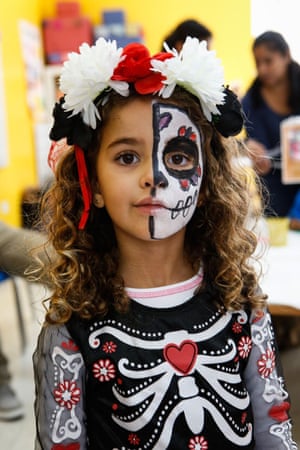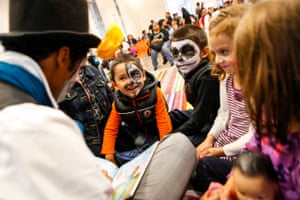A little girl paints her face to look like a sugar skull for the Día de los Muertos celebration at El Museo del Barrio in New York City. Photograph: Gonzalo Marroquin
Halloween – America’s festival of sugar – will undoubtedly be on everyone’s minds on Monday as households across the country get ready to buy enough candy to feed a small village. Parents will return after a long day at the office and prepare to spend their evening awkwardly greeting neighbors as their kids – dressed as Kylo Ren or Iron Man (again) – excitedly wait for more Skittles and 3 Musketeers. But where are the ghosts or the macabre scenes from the past that more genuinely capture the spirit of Halloween? It’s a lament for those who would eschew the lame crop of sexy nurses for a more thoughtful celebration.
But what if I told you there is a family-oriented holiday with 3,000 years of divine tradition that has a much deeper connection with the supernatural and the dead? A three-day festival where parents and children congregate and remember loved ones who have passed away by celebrating their death with face-painting, storytelling and food offerings that honor the spirits of our past. A celebration where Mexican families have been known to carry sugar skulls and marigolds bright as the sun, as they walk in procession ready to greet the spirits of the un-living.
Welcome to Día de los Muertos: Halloween’s antidote.
Día de los Muertos (or Day of the Dead) originates from the Aztecs, who believed that death was just another page in the book of existence and was actually the beginning of a new life. As a ritualistic celebration, they would gather offerings to the goddess Mictecacihuatl (“Lady of the Dead”) for dead children and adults. Spanish conquistadors viewed it as a sacrilegious event but instead of extinguishing it altogether, they decided to combine it with Catholic practice so it would correspond with All Saints Day (1 November) and All Souls’ Day (2 November).
In America, Día de los Muertos has become a holiday where Latino communities can bond together by teaching their children the value of honoring their antepasados (ancestors), as well as showing pride in their heritage . As the America’s demographic landscape keeps diversifying, Día de los Muertos has become a community-builder where people from all backgrounds can take part in this Mexican tradition.
This past weekend in Phoenix, the Desert Botanical Garden hosted a two-day festival featuring traditional dance, face-painting and a market selling jewelry and artifacts. Each day ended with a procession where performers, guests and members of the community would march in unison as they honored the departed. “Nationally, you hear more and more about Day of the Dead,” said Ken Shutz, the garden’s executive director, speaking to AZ Central. “Our country and our state is becoming more multicultural, and it’s higher on everyone’s radar. It’s becoming part of the national consciousness.”
On 15 October, El Museo Del Barrio in New York City organized Super Sábado: Día de los Muertos, where the day began with a procession through Central Park and included a production by Mazarte Dance Company, a group that incorporates indigenous art, dance and Mexican history through various performances across urban communities. The event also featured storytelling, craft-making and various offerings for families across New York.
The museum created this event in 1999 and it has been a big draw for families and children, with more than 1,400 people having attended this year. “For us it’s really important to be a platform for these traditions to live and to bring people together so they can start a conversation about Día de los Muertos,” said Shugart. “And this particular program [Super Sábado] creates a place for young kids to see what their parents’ traditions might have been and so they can carry them to the next generation.”“The great thing about our audience is that they are a wide range of different people from across the five boroughs,” said Maya Shugart, the museum’s senior manager of public programs and engagement. “It’s a diverse group of Spanish and non-Spanish speakers who are either interested in learning more about the celebration or want to celebrate their own cultural traditions.”
Día de los Muertos is also evolving thanks to millennials showing their love for the holiday and introducing it to new audiences on social media. Mexican American fashion blogger, Julie Sariñana celebrates the event annually with her fans on Instagram, while Formula 1 drivers Daniel Ricciardo and Max Verstappen dressed up and promoted it on Twitter as part of Sunday’s Mexican grand prix.



Comments
Post a Comment